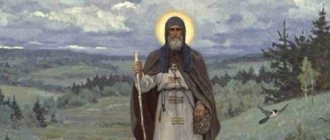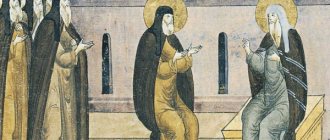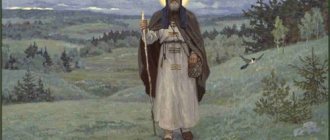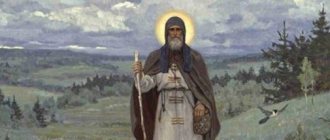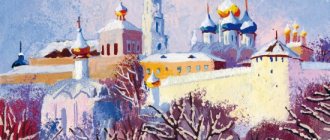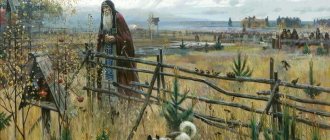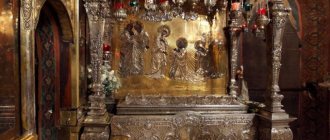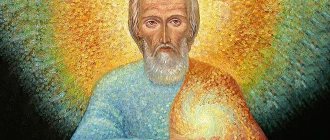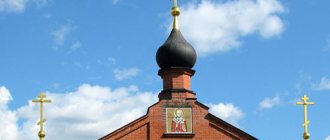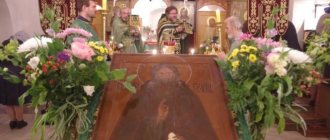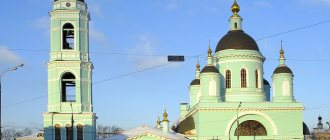May 3, 1314 – September 25, 1392 (78 years old)
4.7
Average rating: 4.7
Total ratings received: 1751.
Sergius of Radonezh (1314–1392) – hieromonk of the Russian Church, transformer of monasticism in Northern Rus', founder of the Holy Trinity Monastery. He was canonized. It was he who, on behalf of the Russian Church, first called for the fight against the Horde yoke.
The material was prepared jointly with a teacher of the highest category, Ekaterina Valerievna Alexandrova.
Experience as a history and social studies teacher - 11 years.
Religious activities
A few years later, a thriving temple of St. Sergius of Radonezh - the Trinity-Sergius Monastery - was formed in this place. Having learned about the establishment of the monastery, Ecumenical Patriarch Philotheus sent the abbot a letter in which he paid tribute to his activities. St. Sergius was a respected figure in princely circles: he blessed rulers before battles and tried them on among themselves.
In a brief biography of Radonezh, it is worth noting that throughout his life, the hieromonk of the Russian Church, in addition to the Trinity-Sergius, founded several more monasteries - Borisoglebsky, Blagoveshchensky, Staro-Golutvinsky, Georgievsky, Andronnikova and Simonov, Vysotsky.
The great hieromonk Sergius died on September 25, 1392.
Sergius of Radonezh - biography. Sergius of Radonezh - 700th anniversary. The exploits of Sergius of Radonezh
Most of us know who Sergius of Radonezh is. His biography is interesting to many people, even those who are far from the church. He founded the Trinity Monastery near Moscow (currently the Trinity-Sergius Lavra), and did a lot for the Russian Church. The saint passionately loved his Fatherland and put a lot of effort into helping his people survive all disasters. We became aware of the life of the monk thanks to the manuscripts of his associates and disciples. The work of Epiphanius the Wise entitled “The Life of Sergius of Radonezh,” written by him at the beginning of the 15th century, is a most valuable source of information about the life of the saint. All other manuscripts that appeared later are, for the most part, processings of his materials.
Place and time of birth
It is not known for certain when and where the future saint was born. His disciple Epiphanius the Wise, in his biography of the saint, speaks of this in a very intricate form. Historians face the difficult problem of interpreting this information. As a result of studying church works of the 19th century and dictionaries, it was established that the birthday of Sergius of Radonezh, most likely, is May 3, 1319. True, some scientists are inclined to other dates. The exact place of birth of the youth Bartholomew (that was the name of the saint in the world) is also unknown. Epiphanius the Wise indicates that the future monk’s father’s name was Cyril, and his mother’s name was Maria. Before moving to Radonezh, the family lived in the Rostov Principality. It is believed that St. Sergius of Radonezh was born in the village of Varnitsa in the Rostov region. At baptism the boy was given the name Bartholomew. His parents named him in honor of the Apostle Bartholomew.
Childhood and first miracles
There were three sons in the family of Bartholomew's parents. Our hero was the second child. His two brothers, Stefan and Peter, were smart children. They quickly mastered literacy, learned to write and read. But Bartholomew’s studies were never easy. No matter how much his parents scolded him or his teacher tried to reason with him, the boy could not learn to read, and the holy books were inaccessible to his understanding. And then a miracle happened: suddenly Bartholomew, the future Saint Sergius of Radonezh, learned to read and write. His biography is indicative of how faith in the Lord helps to overcome any difficulties in life. Epiphanius the Wise spoke about the boy’s miraculous learning to read and write in his “Life.” He says that Bartholomew prayed long and hard, asking God to help him learn to write and read in order to know the Holy Scriptures. And one day, when Father Kirill sent his son to look for grazing horses, Bartholomew saw an old man in a black robe under a tree. The boy, with tears in his eyes, told the saint about his inability to learn and asked him to pray for him before the Lord.
The elder told him that from this day on the boy would understand reading and writing better than his brothers. Bartholomew invited the saint to his parents' house. Before their visit, they went into the chapel, where the youth read a psalm without hesitation. Then he hurried with his guest to his parents to please them. Cyril and Maria, having learned about the miracle, began to praise the Lord. When they asked the elder what this amazing phenomenon meant, they learned from the guest that their son Bartholomew was marked by God in his mother’s womb. Thus, when Mary came to church shortly before giving birth, the child in her mother’s womb cried out three times as the saints sang the liturgy. This story of Epiphanius the Wise was reflected in the painting by the artist Nesterov “Vision to the Youth Bartholomew.”
First exploits
What else was noted in the childhood of St. Sergius of Radonezh in the stories of Epiphanius the Wise? The saint’s disciple reports that even before the age of 12, Bartholomew observed strict fasts. On Wednesday and Friday he did not eat anything, and on other days he ate only water and bread. At night, the youth often did not sleep, devoting time to prayer. All this became the subject of a dispute between the boy’s parents. Maria was embarrassed by these first exploits of her son.
Relocation to Radonezh
Soon the family of Kirill and Maria became poor. They were forced to move to housing in Radonezh. This happened around 1328-1330. The reason why the family became impoverished is also known. It was a difficult time in Rus', which was under the rule of the Golden Horde. But not only the Tatars then robbed the people of our long-suffering homeland, imposing an unbearable tribute on them and carrying out regular raids on settlements. The Tatar-Mongol khans themselves chose which of the Russian princes would rule in a particular principality. And this was no less a difficult test for the entire people than the invasion of the Golden Horde. After all, such “elections” were accompanied by violence against the population. Sergius of Radonezh himself often spoke about this. His biography is a vivid example of the lawlessness that was happening in Rus' at that time. The Principality of Rostov went to the Grand Duke of Moscow Ivan Danilovich. The father of the future saint got ready and moved with his family from Rostov to Radonezh, wanting to protect himself and his loved ones from robbery and want.
Monastic life
It is unknown when the birth of Sergius of Radonezh took place for certain. But we have reached accurate historical information about his childhood and youth life. It is known that, while still a child, he prayed fervently. When he turned 12 years old, he decided to take monastic vows. Kirill and Maria did not object to this. However, they set a condition for their son: he should become a monk only after their death. After all, Bartholomew eventually became the only support and support for the old people. By that time, brothers Peter and Stefan had already started their own families and lived separately from their elderly parents. The youth did not have to wait long: soon Kirill and Maria died. Before their death, according to the custom of that time in Rus', they first took monastic vows and then the schema. After the death of his parents, Bartholomew went to the Khotkovo-Pokrovsky Monastery. There his brother Stefan, who by that time was already a widower, took monastic vows. The brothers were not here for long. Striving for “the strictest monasticism,” they founded a hermitage on the banks of the Konchura River. There, in the middle of the remote Radonezh forest, in 1335 Bartholomew built a small wooden church named in honor of the Holy Trinity. Now in its place stands a cathedral church in the name of the Holy Trinity. Brother Stefan soon moved to the Epiphany Monastery, unable to withstand the ascetic and too harsh lifestyle in the forest. In the new place he will then become abbot.
And Bartholomew, left completely alone, called Abbot Mitrofan and took monastic vows. Now he was known as monk Sergius. At that point in his life he was 23 years old. Soon monks began to flock to Sergius. On the site of the church a monastery was formed, which today is called the Trinity Lavra of St. Sergius. Father Sergius became the second abbot here (the first was Mitrofan). The abbots showed their students an example of great hard work and humility. Monk Sergius of Radonezh himself never took alms from parishioners and forbade monks to do this, calling on them to live only by the fruits of the labor of their hands. The fame of the monastery and its abbot grew and reached the city of Constantinople. Ecumenical Patriarch Philotheus, with a special embassy, sent St. Sergius a cross, a schema, a paraman and a letter, in which he paid tribute to the abbot for his virtuous life and advised him to introduce the monastery in the monastery. Heeding these recommendations, the Radonezh abbot introduced a community-living charter in his monastery. Later it was adopted in many monasteries in Rus'.
Service to the Fatherland
Sergius of Radonezh did a lot of useful and good things for his homeland. The 700th anniversary of his birth is celebrated this year. D. A. Medvedev, being the President of the Russian Federation, signed a decree on the celebration of this memorable and significant date for all of Russia. Why is such importance attached to the life of the saint at the state level? The main condition for the invincibility and indestructibility of any country is the unity of its people. Father Sergius understood this very well in his time. This is also obvious to our politicians today. The saint’s peacemaking activities are well known. Thus, eyewitnesses claimed that Sergius, with meek, quiet words, could find his way to the heart of any person, influence the most bitter and rude hearts, calling people to peace and obedience. Often the saint had to reconcile warring parties. So, he called on the Russian princes to unite, putting aside all differences, and submit to the power of the Prince of Moscow. This subsequently became the main condition for liberation from the Tatar-Mongol yoke. Sergius of Radonezh made a significant contribution to the Russian victory in the Battle of Kulikovo. It is impossible to talk about this briefly. Grand Duke Dmitry, who later received the nickname Donskoy, before the battle came to the saint to pray and ask him for advice whether the Russian army could march against the godless. The Horde Khan Mamai gathered an incredible army to enslave the people of Rus' once and for all.
The people of our Fatherland were gripped by great fear. After all, no one has ever managed to defeat an enemy army. The Monk Sergius answered the prince’s question that defending the Motherland was a godly task, and blessed him for the great battle. Possessing the gift of foresight, the holy father predicted Dmitry's victory over the Tatar Khan and his return home safe and sound with the glory of a liberator. Even when the Grand Duke saw the countless enemy army, nothing wavered in him. He was confident of a future victory, which St. Sergius himself blessed him with.
Monasteries of the Saint
The Year of Sergius of Radonezh is celebrated in 2014. Particularly large celebrations on this occasion should be expected in the temples and monasteries founded by him. In addition to the Trinity-Sergius Lavra, the saint erected the following monasteries:
• Blagoveshchensky in the city of Kirzhach in the Vladimir region;
• Vysotsky Monastery in the city of Serpukhov;
• Staro-Golutvin near the city of Kolomna in the Moscow region;
• St. George's Monastery on the Klyazma River.
In all these monasteries, disciples of Holy Father Sergius became abbots. In turn, followers of his teachings founded more than 40 monasteries.
Miracles
The Life of Sergius of Radonezh, written by his disciple Epiphanius the Wise, tells that in his time the rector of the Trinity-Sergius Lavra performed many miracles. Unusual phenomena accompanied the saint throughout his entire existence. The first of them was associated with his miraculous birth. This is the story of the wise one about how the child in the womb of Mary, the mother of the saint, cried out three times during the liturgy in the temple. And all the people in it heard this. The second miracle is the teaching of the youth Bartholomew to read and write. It was described in detail above. We also know about such a miracle associated with the life of a saint: the resurrection of a youth through the prayers of Father Sergius. Near the monastery lived one righteous man who had strong faith in the saint. His only son, a young boy, was mortally ill. The father brought the child in his arms to the holy monastery to Sergius so that he could pray for his recovery. But the boy died while his parent was presenting his request to the abbot. The inconsolable father went to prepare a coffin to put his son’s body in it. And Saint Sergius began to pray fervently. And a miracle happened: the boy suddenly came to life. When the grief-stricken father found his child alive, he fell at the feet of the monk, offering praise.
And the abbot ordered him to get up from his knees, explaining that there was no miracle here: the boy was simply cold and weak when his father carried him to the monastery, but in the warm cell he warmed up and began to move. But the man could not be convinced. He believed that Saint Sergius showed a miracle. Nowadays there are many skeptics who doubt that the monk performed miracles. Their interpretation depends on the ideological position of the interpreter. It is likely that a person who is far from believing in God will prefer not to focus on such information about the miracles of the saint, finding another, more logical explanation for them. But for many believers, the story of life and all the events associated with Sergius has a special, spiritual meaning. For example, many parishioners pray that their children will achieve literacy and successfully pass transfer and entrance exams. After all, the youth Bartholomew, the future Saint Sergius, at first also could not master even the basics of study. And only fervent prayer to God led to a miracle happening when the boy miraculously learned to read and write.
Old age and death of the monk
The life of Sergius of Radonezh shows us an unprecedented feat of service to God and the Fatherland. It is known that he lived to a ripe old age. When he was lying on his deathbed, sensing that he would soon appear at the judgment of God, he called the brethren for the last time for instruction. He called on his disciples, first of all, to “have the fear of God” and bring to people “spiritual purity and unfeigned love.” The abbot died on September 25, 1392. He was buried in Trinity Cathedral.
Veneration of the Reverend
There is no documented data about when and under what circumstances people began to perceive Sergius as a righteous man. Some scientists are inclined to believe that the rector of the Trinity Monastery was canonized in 1449-1450. Then, in the letter of Metropolitan Jonah to Dmitry Shemyaka, the Primate of the Russian Church calls Sergius a venerable one, classifying him among the wonderworkers and saints. But there are other versions of his canonization. The Day of Sergius of Radonezh is celebrated on July 5 (18). This date is mentioned in the works of Pachomius Logothetes. In them he tells that on this day the relics of the great saint were found.
Throughout the history of the Trinity Cathedral, this shrine left its walls only in the event of a serious threat from the outside. Thus, two fires that occurred in 1709 and 1746 caused the removal of the saint’s relics from the monastery. When Russian troops left the capital during the invasion of the French led by Napoleon, the remains of Sergius were taken to the Kirillo-Belozersky Monastery. In 1919, the atheist-minded government of the USSR issued a decree on the opening of the relics of the saint. After this uncharitable deed was completed, the remains were transferred to the Sergiev Historical and Art Museum as an exhibit. Currently, the relics of the saint are kept in the Trinity Cathedral. There are other dates for the memory of his abbot. September 25 (October 8) is the day of Sergius of Radonezh. This is the date of his death. Sergius is also commemorated on July 6 (19), when all the holy monks of the Trinity-Sergius Lavra are glorified.
Temples in honor of the saint
Since ancient times, Sergius of Radonezh has been considered one of the most revered saints in Rus'. His biography is replete with facts of selfless service to God. Many temples are dedicated to him. In Moscow alone there are 67 of them. Among them are the Church of St. Sergius of Radonezh in Bibirevo, the Cathedral of St. Sergius of Radonezh in the Vysokopetrovsky Monastery, the Church of St. Sergius of Radonezh in Krapivniki and others. Many of them were built in the 17th-18th centuries. There are many churches and cathedrals in various regions of our Motherland: Vladimir, Tula, Ryazan, Yaroslavl, Smolensk and so on. There are even monasteries and sanctuaries abroad founded in honor of this saint. Among them are the Church of St. Sergius of Radonezh in the city of Johannesburg in South Africa and the Monastery of St. Sergius of Radonezh in the city of Rumia, in Montenegro.
Images of the Reverend
It is also worth remembering the many icons created in honor of the saint. The oldest image of it is an embroidered cover made in the 15th century. Now it is in the sacristy of the Trinity-Sergius Lavra.
One of the most famous works of Andrei Rublev is the “Icon of St. Sergius of Radonezh,” which also contains 17 marks about the life of the saint. Not only icons, but also paintings were written about events related to the abbot of the Trinity Monastery. Among Soviet artists, one can highlight M. V. Nesterov. The following of his works are known: “The Works of Sergius of Radonezh”, “The Youth of Sergius”, “Vision to the Youth Bartholomew”. Sergius of Radonezh. A short biography of him is unlikely to be able to tell about what an extraordinary person he was, how much he did for his Fatherland. Therefore, we dwelled in detail on the biography of the saint, information about which was taken mainly from the works of his disciple Epiphanius the Wise.
Watched(55854)
Interesting Facts
- The Life of Sergius tells that Bartholomew learned to read and write thanks to the blessing of the holy elder.
- Among the students of Sergius of Radonezh were such famous religious figures as Abraham of Galitsky, Pavel Obnorsky, Sergius of Nuromsky, Venerable Andronik, Pachomius of Nerekhta and many others.
- The life of the saint inspired many writers (N. Zernov, N. Kostomarov, L. Charskaya, G. Fedotov, K. Sluchevsky, etc.) to create works of art about his fate and deeds, including a number of books for children. The biography of Sergius of Radonezh is studied by schoolchildren in the 6th grade.
Love and trust in God
Neither simplicity nor humility is possible if a person does not have love for God and complete trust in His providence. True peace is born in trust. Everything (except our sins) is glory to God. Everything is as it should be.
It's easy to talk about trust when everything in life is arranged. It’s hard when it’s a forest and a monastery, where new novices have just gathered around you. Sultry summer, rainy autumn, frosty winter. There are often periods when food runs out and, by and large, there is nowhere to get it from.
In such conditions it is very easy to lose mental “balance”. Just as we lose it when circumstances do not at least slightly fit into our plans or our ideas of “control.” How many thoughts that “I’m unhappy” were born at such moments!
According to the recollections of his disciples, St. Sergius of Radonezh always tried to maintain peace and be faithful to the principle: “do what God wants from you, and come what may.”
The monastery grew. The Monk Sergius lived to a ripe old age. And many of his students became saints.
Battle of Kulikovo
Sergius of Radonezh was a great peacemaker who made an invaluable contribution to the unity of the people. With quiet and meek speeches, he found his way to the hearts of people, calling for obedience and peace. He reconciled the warring parties, calling for submission to the Prince of Moscow and the unification of all Russian lands. Subsequently, this created favorable conditions for liberation from the Tatar-Mongols.
Sergius of Radonezh blesses Dmitry Donskoy
The role of Sergius of Radonezh in the battle on the Kulikovo field was great. Before the battle, Grand Duke Dmitry Donskoy came to the saint to pray and ask for advice on whether it was a godly thing for a Russian man to fight against the atheists. Khan Mamai and his huge army wanted to enslave the freedom-loving, but fear-ridden Russian people. The Monk Sergius gave the prince his blessing for the battle and predicted victory over the Tatar horde.
Sergius of Radonezh blesses Dmitry Donskoy for the Battle of Kulikovo
Together with the prince, he sends two monks, thereby violating church canons that forbade monks to fight. Sergius was ready to sacrifice the salvation of his soul for the sake of the Fatherland. The Russian army won the Battle of Kulikovo on the day of the Nativity of the Blessed Virgin Mary. This became another evidence of the special love and patronage of the Mother of God on Russian soil. The prayer of the Most Pure One accompanied the saint’s entire life; his favorite cell icon was “Our Lady Hodegetria” (Guide). Not a day passed without singing an akathist - a hymn of praise dedicated to the Mother of God.
Mary gave her word to dedicate the born child to the Lord
She made a vow in prayer to dedicate the baby to the Almighty and raise him according to Christian canons.
And on May 3, 1314, a boy, a blessed son, was born to them. On the fortieth day, the happy parents decided to bring him to church. Father Michael, who baptized him, named him Bartholomew.
Feeling that baby Bartholomew was special, he exclaimed:
“Rejoice, for this child is the chosen vessel of our God and the abode of the Holy Trinity.”
At baptism, the baby was given the name Bartholomew, fragment of the life
In order to see the relics of the saints, you need to get to the Intercession Monastery
To this day, their holy relics are located in Khotkovo, in the St. Nicholas Cathedral of the Intercession Monastery. The monastery is located at the address: Moscow region, Sergievo-Posadsky district, Khotkovo city, Kooperativnaya street, possession 2.
From Moscow you can get by train, departing from the Yaroslavsky station to Sergiev Posad, get off at the Khotkovo station. From the opposite side of the station, a bus leaves for the monastery. From the final stop it takes about 10 minutes to walk.
Official website of the Intercession Monastery in Khotkovo
More information about how to get there can be found on the official website of the monastery.
The elder predicted to Bartholomew that he would become special
One day a boy met an old man in a field. He invited the schema-monk to his parents’ house, and at dinner the elder predicted that Bartholomew would be great and virtuous before people and the Almighty. Having blessed the youth, the elder left, and from that time on Bartholomew began to easily read and write. He pleased his parents with his diligence and piety.
Fragment of life: Hospitality is one of the benefactors of Mary and Cyril
From birth, Bartholomew observed fasting, which surprised his parents
Article “Is it possible to eat sugar during fasting” on hranitel.club
To the surprise of his righteous parents, Bartholomew kept fast from birth. On Wednesday and Friday he did not drink milk, and refused to eat on other days if Maria ate meat the day before. Accustomed to fasting in the womb, he set an example for his parents.
In the growing Bartholomew, the signs of being chosen by God were increasingly expressed. He respected his parents, showed humility and obedience, and prayed a lot. At the age of seven, the reverend parents sent the boy to learn to read and write so that he could read spiritual books himself.
Fragment of life: Youth Bartholomew asks his parents for blessings for monasticism
His brothers also studied with him: Stefan the elder and Peter the younger. Unlike his brothers, Bartholomew had a blast learning. His friends laughed at him and his teacher scolded him. At night, hiding from prying eyes, little Bartholomew cried for a long time and fervently prayed to God.
Saints Maria and Kirill and their sons are forced to move to Radonezh
Frequent Tatar-Mongol raids brought misery and poverty to Varnitsa. The principality suffered under the rule of Ivan Kalita. One of the Moscow nobles was appointed mayor to the Rostov lands, who continued to rob and oppress the local residents.
Rostovites began to leave the city. In his old age, Kirill and his family had to move to Radonezh. He was supposed to receive an estate and service from the Moscow princes. This responsibility was taken on by Cyril’s eldest son, already a family member, Stefan.
Reverend Kirill accompanied the Grand Dukes to the Golden Horde
Saints Cyril and Mary of Radonezh lived in the village of Varnitsa near Rostov
Four miles from the city of Rostov the Great, near the Ishni River, in the village of Varnitsa, at the beginning of the 14th century there was a boyar estate of Cyril and Maria. The parents of Sergius of Radonezh led a pious life, showing humility and trusting in the Lord in prayer.
Icon of Saints Cyril and Mary with Life
More than once Cyril of Radonezh accompanied the Rostov princes to the war with the Golden Horde. Being a wealthy owner, boyar Kirill did not disdain land labor in peacetime.
The family led a godly life, fulfilling the commandments of the Lord and observing church canons. Saints Cyril and Maria helped the poor and gave alms.
Their special grace was hospitality. They provided their shelter to any traveler, pilgrim, or vagabond with a dear soul and God's prayer, shared their table, and packed their knapsack for the journey.
Fragment of the life from the icon. Saints Cyril and Mary lived modestly
Maria and Kirill ended their lives in the monastery
At the end of their lives, Kirill and Maria decided to go to the Khotkovsky Monastery of the Intercession of the Blessed Virgin Mary, which was both female and male.
They took monastic vows, and then became schema-monk Kirill and schema-nun Maria. In the same monastery, their eldest son Stefan, who by this time had become a widower, took monastic vows.
Fragment of life: Saints Cyril and Mary take monastic vows at the Khotkovsky Monastery
Before their death, in 1337, Mary and Cyril blessed Bartholomew to become a monk. The Khotkovo Intercession Monastery became their last refuge and the place where the saints were buried.
